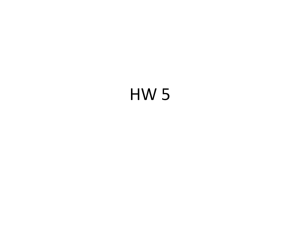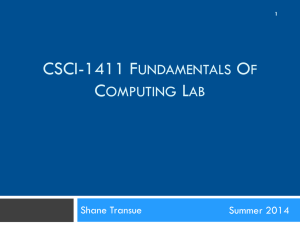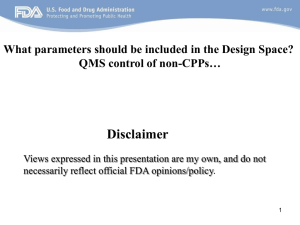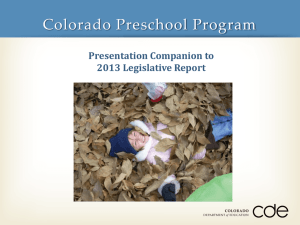Government Programs: Collecting what you are due as a citizen and
advertisement
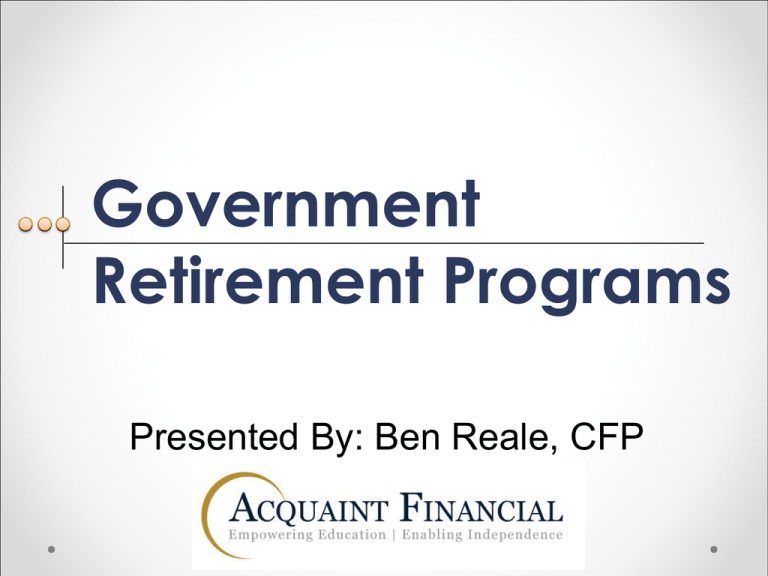
Government Retirement Programs Presented By: Ben Reale, CFP Canada Pension Plan (CPP) • Established in 1966 • In 1999, $22B in contributions were made to the CPP • Mandatory contributions are made by those aged 18 to 65; optional for those aged 65 to 70 • Indexed annually in January • ‘Normal’ retirement is age 65 • Both employee and employer each contribute 4.95% on income between $3,500 and $50,100 (YMPE) o $2,306.70 max employee portion contribution o Self employed contributes 9.9% or $4,613.40 CPP benefits CPP sharing • Aim is to reduce total tax paid but look out for OAS claw-back and other tax credits that may be affected • Both must be 60 or older • Can split up to the number of years living together while contributing to CPP • Total benefits paid don’t change and upon death the full amount reverts back to the originator Statement of contributions • • • • • It is important to obtain a copy of your statement Ensure all contributions are correct Apply the proper dropout provisions Call 1-800-277-9914 Visit www.sdc.gc.ca o Navigate to Explore our site > Programs and policies > CPP > CPP statement of contributions online Dropout provisions • Any years you were on CPP disability • Any years you left or reduced work to care for a child under the age of 7 o You must apply for this provision • 16% of your lowest earning years (up to 7.5) CPP has changed • Changes to be phased in from 2012 to 2016 • If you wait until after age 65 to take CPP, it will increase by a larger percentage than before • If you take the CPP before age 65 it will decrease by a larger percentage than before • If you are under 65, receiving CPP and still working, you and your employer will be required to make contributions • If you are between 65 and 70 and receiving CPP and still working, making contributions for a higher pension will be optional CPP has changed • The dropout provision for low income earning years will increase • You will be able to begin receiving your CPP without having to stop work • In the future visit www.servicecanada.gc.ca and search for the CPP calculator o Currently it is being updated to reflect the new upcoming Post Retirement Benefits Current vs. new rules Old rules New rules Collecting CPP aged 60-64 Reduced by 6%/year or 0.5%/month Reduced by 7.2%/year or 0.6%/month Collecting CPP aged 66-70 Increased by 6%/year or 0.5%/month Increased by 8.4%/year or 0.7%/month Under age 65, collecting CPP and still working No contributions required Contributions mandatory towards Post Retirement Benefit (PRB) CPP at age 60/70 30% reduction/30% increase 36% reduction/42% increase Age 65-70, collecting CPP and still working No contributions allowed Additional contributions to PRB voluntary Low earning years dropout provision 15% up to 7 years 16% up to 7.5 years Starting to collect CPP Must ‘substantially’ cease work (2 month minimum) No interruption needed When should you start? • Depends on your life expectancy • Evaluate your retirement income needs and where that income will come from o Government programs, employer plans, Tax Free Savings Accounts, Registered Retirement Savings Programs, other personal assets o If there is a gap, can and should CPP fill it? • Remember any reduction for taking it early or increase for taking it later is permanent • The Post Retirement Benefit is interesting, consider taking CPP early and then continuing contributions while working • If you stop working, start collecting CPP OAS eligibility Scenario #1 – people living in Canada • You are 65 years of age or older • You live in, are a legal resident of, or be a citizen of Canada when your application is approved • You must have lived in Canada for at least 10 years after turning 18 OAS eligibility Scenario #2 – people living outside Canada • You are 65 years of age or older • You were a Canadian citizen or legal resident the day before you left Canada • You must have lived in Canada for at least 20 years after turning 18 GIS eligibility • Guaranteed Income Supplement • Designed to assist low income seniors already receiving OAS • Income tested program o Net income includes all sources of income except OAS, GIS and allowance The Allowance • A monthly benefit for low income seniors aged between 60 and 64 • Spouse or common-law partner must be eligible or currently receiving OAS and the GIS • It must be applied for either online through www.servicecanada.gc.ca or by calling 1-800-277-9914 • Must be reported on your tax return but it is NOT taxable OAS, GIS & Allowance benefits More benefits information • OAS has a claw-back that reduces your payment based on your net income • Claw-back starts eroding OAS at $69,562 and completely eliminates it at $112,772 • About 5% of seniors have some OAS clawed back & less than 2% have it completely taken • For an exact benefits calculation visit www.servicecanada.gc.ca • Home > OAS (under Seniors) > What are the payment rates? (under Financial Information) > Tables of rates (under Related information) International benefits • Canada does have social security agreements with many other countries • If you’ve contributed to a social security system in a partner country you may be eligible for benefits in Canada • For more information visit www.servicecanada.gc.ca and click on HOME > Seniors > International benefits OR call 1-800454-8731 Will you have enough? • Estimate your expenses in retirement • Estimate your income in retirement from all sources • Will you have enough? • STEW! o Save more o Take less o Earn more o Work longer Questions & Answers Thank you! Presented By: Ben Reale, CFP
